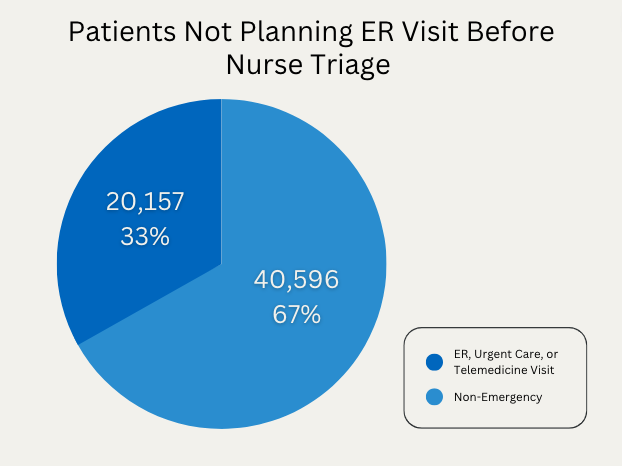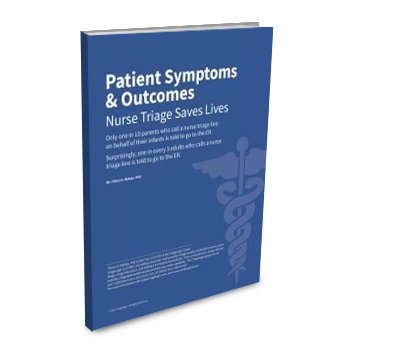We recently discussed why a nurse triage service is important for helping patients avoid unnecessary ER visits. The same holds true for those patients who have serious conditions, but hesitate to seek emergency care. Read on to learn why implementing nurse triage can reduce patient morbidity and mortality, and lower the associated healthcare costs at the same time.
Why Patients Delay Care
Many patients can feel self-conscious about their health, and don’t like to go to the ER unless they think it’s absolutely necessary. They may also be worried about insurance costs and would prefer waiting to see if their symptoms improve. But this hesitancy can put their overall health at risk if they’re exhibiting symptoms associated with underlying conditions: for instance, neck and shoulder pain that may be precursors to a heart attack. Even if these symptoms don’t seem problematic immediately, it can take a very short period of time — sometimes less than 24 hours — before they may worsen. Having a qualified triage nurse who can talk with that patient and evaluate all of their symptoms using Schmitt-Thompson protocols will give them a definitive answer about whether or not they need the emergency department.
Not only does this lower the mortality rate at a given practice, it also helps patients avoid high medical bills. Those who may experience symptoms but continue to delay care may find themselves ultimately needing the ER anyway — and potentially an ambulance to get them there — and will have to pay more out of pocket compared to those treated early by a PCP.
Conversely, patients who take active roles in their own healthcare are better able to avoid these situations. But they still need to know when their symptoms warrant going to the ER. Nurse triage is the best means of determining that.
Benefits of Nurse Triage
Nurse triage is a service where registered nurses talk with patients — either over the phone or through telehealth videoconferencing — to evaluate their symptoms and determine the best dispositions for care.
Those dispositions can be applied to both pediatric and adult cases. For a more in-depth discussion of how these age groups differ, and why there is a high referral rate for ER visits for adults, check out our ebook, Patient Symptoms & Outcomes.
Nurse triage should include:
- Understanding the 10-step process for handling each call;
- Access to the most up-to-date versions of daytime and after-hours triage protocols;
- Use of intuitive nurse triage software to document all patient interactions; and
- Proper training on how to interact with all types of patients.
This service has demonstrated its ability to enhance patient health outcomes and provider revenue by assisting patients in comprehending the gravity of their symptoms, whether related to physical or mental health. It covers a spectrum from moderate to severe or even chronic conditions, and effectively identifies the suitable healthcare professionals capable of providing treatment. This can even extend to ER referrals when necessary.
Morbidity and Mortality Examples
In a recent study that we performed, we identified 60,753 patient callers who did not originally intend to go to the ER. Once evaluated by our triage nurses, we found that:
- 40,596 were correct and did not need to go;
- 20,157 did needed urgent medical attention including ER visit, urgent care visit or a telemedicine visit with a doctor (33.2 percent); and
- 343 were actually instructed to call 911!

Here are some examples of when our triage nurses have advised patients to seek treatment at an emergency department.
Case 1 | Case 2 | Case 3 | |
Case | 3-Day-Old Newborn With Loss of Appetite | 22-Year-Old Adult With Chest Congestion | 47-Year-Old Adult With Chest Pain and Vertigo |
Problem | A father called our nurses, worried that his newborn was not feeding or latching after just coming home from the hospital. The baby had been feeding and latching well earlier that day. | A patient called our nurses to ask for a refill on his inhaler, which expired earlier that year. He complained of chest congestion, a runny nose, and a sore throat that had started two days prior. | A patient called our nurses and said that he was feeling chest pain, vertigo, dizziness, and headaches after taking his first dose of an SSRI earlier that day. |
Outcome | After assessing that the newborn had demonstrated abnormal behavior, our nurses recommended emergency response. | After asking further questions about the patient’s symptoms, our nurses learned that he had difficulty breathing, shortness of breath, and a pulse of over 100 BPM. They then determined that the patient’s case was more severe than he realized, and directed him to the ER. | After learning that the patient’s chest pain was intermittent, but increasing in its severity, our nurses directed him to the ER. |
Reduce Your Morbidity and Mortality Rates With TriageLogic
Nurse triage plays a crucial role in assisting a wide range of cases, from new patients experiencing moderate symptoms like dehydration, to established patients with chronic conditions like heart disease. Whether you manage this service in-house using our software and licensed protocols, or choose to outsource it to our 24/7 medical call center, you’ll immediately see how these nurses can reduce incident rates and the number of deaths.
Contact us today to talk about a program to reduce morbidity and mortality at your practice.
About TriageLogic
TriageLogic is a URAC-accredited, physician-led provider of top-quality nurse telehealth technology, remote patient monitoring, and medical call center solutions. Founded in 2007, the TriageLogic Group now serves more than 22,000 physicians and covers over 42 million lives nationwide.







